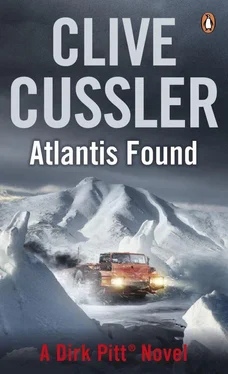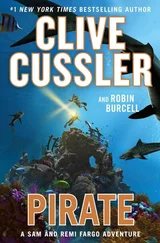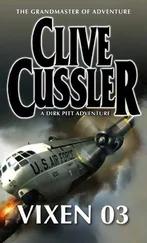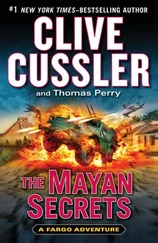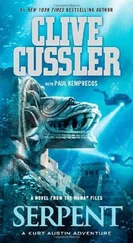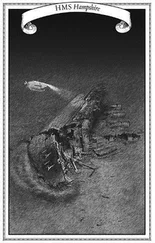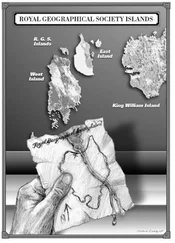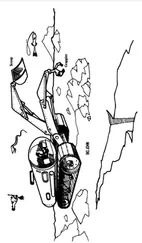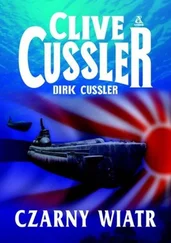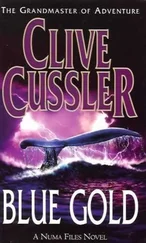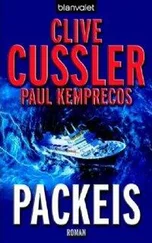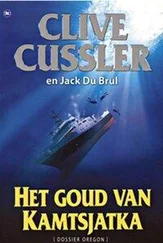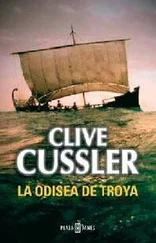"To decipher an unknown alphabetic writing, the first trick is to separate the consonants from the vowels. Since I see no indication that they represent ideas or objects, I'm assuming that the symbols are alphabetic and they record sounds of words."
"What is the origin of the first alphabet?" asked Yaeger.
"Hard evidence is scarce, but most epigraphists believe it was invented in ancient Canaan and Phoenicia somewhere between 1700 and 1500 B.C., and is labeled as North Semitic. Leading scholars disagree, of course. But they do tend to agree that early Mediterranean cultures developed the awakenings of an alphabet from prehistoric geometric symbols. Much later, the Greeks adapted and refined the alphabet, so the letters we write today are related to theirs. Further developments came from the Etruscans, followed by the Romans, who borrowed heavily to form the written language of Latin and whose later classic characters eventually formed the twenty-six-letter alphabet you and I use today."
"Where do we begin?"
"We'll be starting from scratch," said Pat, referring to her notes. "I'm unaware of any other ancient writing systems whose symbols match those inscribed in the chamber. There seems to be no influence either way, which is most unusual. The only remote similarity is to the Celtic Ogham alphabet, but there any resemblance ends."
"I almost forgot." Yaeger handed her a small batonlike shaft with a miniature camera at one end. "Max has already coded the symbols. If you want me to help you from my end with any calculations, just aim the camera at the symbol and its sequence in the inscriptions you wish to study, and I'll work at developing a decipher program."
"Sounds good," said Pat, happy to be back in the harness again. "First, let's list the different symbols and get a count on how many times each is represented. Then we can try working them into words."
"Like the and and."
"Most of the ancient script did not include words we take for granted today. I also want to see if we can detect the vowels before tackling the consonants."
They worked through the day without a break. At noon, Yaeger sent word down to the NUMA cafeteria to send up sandwiches and soft drinks. Pat was becoming increasingly frustrated. The symbols looked maddeningly simple to decipher, and yet by five o'clock she had had little or no success in untangling their definitions.
"Why is it the numbering system was so easy to break, but the alphabet so impossible?" she muttered irritably.
"Why don't we knock off until tomorrow," Yaeger suggested.
"I'm not tired."
"Neither am I," he concurred. "But we'll have a fresh outlook. I don't know about you, but my best solutions always come to me in the middle of the night. Besides, Max doesn't require sleep. I'll put her on the inscriptions during the night. By morning, she should have some ideas on the translation."
"I have no sensible argument."
"Before we knock off, I'll call up Max and see if she's made any progress with the stars."
Yaeger's fingers didn't have to play over the keyboard. He simply pressed a transmit button and said, "Max, are you there?"
Her scowling face came over the monitor. "What took you and Dr. O'Connell so long to get back to me? I've been waiting for nearly two hours."
"Sorry, Max," said Yaeger, without a deep sense of regret. "We were busy."
"You didn't spend but a few hours on the project," said Pat naively. "Did you strike out?"
"Strike out, hell," Max snapped. "I can tell you exactly what you want to know."
"Start with how you came to your conclusions," Yaeger commanded.
"You didn't think I was going to calculate movement of the stars myself, did you?"
"It was your project."
"Why should I strain my chips when I can get another computer to do it?"
"Please, Max, tell us what you discovered."
"Well, first of all, finding the coordinates of celestial objects in the sky takes a complicated geometric process. I won't get into boring detail on how to determine the altitude, azimuth, right ascension, and declination. My problem was to determine the sites where the coordinates engraved in the rock of the chamber were measured. I managed to calculate the original sites where the observers took their sightings within a few miles. Also the stars they used to measure deviations over many, many years. The three stars in the belt of the constellation of Orion, the hunter, all move. Sirius, the dog star, who sits near the heel of Orion, is fixed. With these numbers in hand, I tapped into the astrometry computer over at the National Science Center."
"Shame on you, Max," admonished Yaeger. "You could get me into big trouble raiding another computer network."
"I think the computer over at NSC likes me. He promised to erase my inquiry.
"I hope you can take him at his word," grunted Yaeger. It was an act. Yaeger had tapped into outside computer networks for unauthorized data hundreds of times.
"Astrometry," Max continued unperturbed, "in case you don't know, is one of the oldest branches of astronomy, and deals with determining the movements of stars." Max paused. "Follow me?"
"Go on," Pat urged.
"The guy in the computer over at NSC isn't up to my standards, of course, but since this was an elementary program for him, I sweet talked him into working out the deviation between positions of Sirius and Orion when the chamber was built with their present coordinates in the sky."
"You dated the chamber?" Pat murmured, holding her breath.
"I did."
"Is the chamber a hoax?" Yaeger asked, as if afraid of the answer.
"Not unless those old hard-rock Colorado miners you're worried about were first-class astronomers."
"Please, Max," Pat begged. "When was the chamber built and the inscriptions engraved on its walls?"
"You must remember, my time estimate is give or take a hundred years."
"It's older than a hundred years?"
"Would you believe," Max said slowly, dragging out the suspense, "a figure of nine thousand."
"What are you saying?"
"I'm saying your chamber was chiseled out of the Colorado rock sometime around 7100 B.C."
Giordino lifted the Bell-Boeing 609 executive tilt-rotor aircraft straight up into a Persian blue sky outside Cape Town, South Africa, just after four in the morning. Taking off like a helicopter, its twin prop-rotor engines tilted at ninety degrees, the huge propellers beating the tropical air, the aircraft rose vertically, until the tilt-rotor was five hundred feet off the ground. Then Giordino shifted the controls of the mechanical linkage that enabled both prop rotors to swing horizontal and send the aircraft into level flight.
The 609 seated up to nine passengers, but for this trip she was empty except for a bundle of survival gear strapped to the floor. Giordino had chartered the plane in Cape Town because the nearest NUMA research ship was more than one thousand miles away from the Crozet Islands.
A helicopter could not have made the 2,400-mile round trip without refueling at least four times, and a normal mold-engine aircraft that could go the distance would have had no place to land once it reached the volcanic island. The Model 609 tilt-rotor could land any place a helicopter could and seemed the ideal craft for the job. Depending on the freakish whims of the winds, the flight should average four hours each way. The fuel would have to be monitored closely. Even with modified wing tanks, Giordino calculated that he would only have an extra hour and a half of flying time for the journey back to Cape Town. It wasn't enough to ensure a mentally soothing flight, but Giordino was never one to play a safe game.
Thirty minutes later, as he reached 12,000 feet and banked southeast over the Indian Ocean, he set the throttles at the most fuel-efficient cruise setting, watching the airspeed indicator hover at slightly under three hundred miles per hour. Then he turned to the small man sitting in the copilot's seat.
Читать дальше
